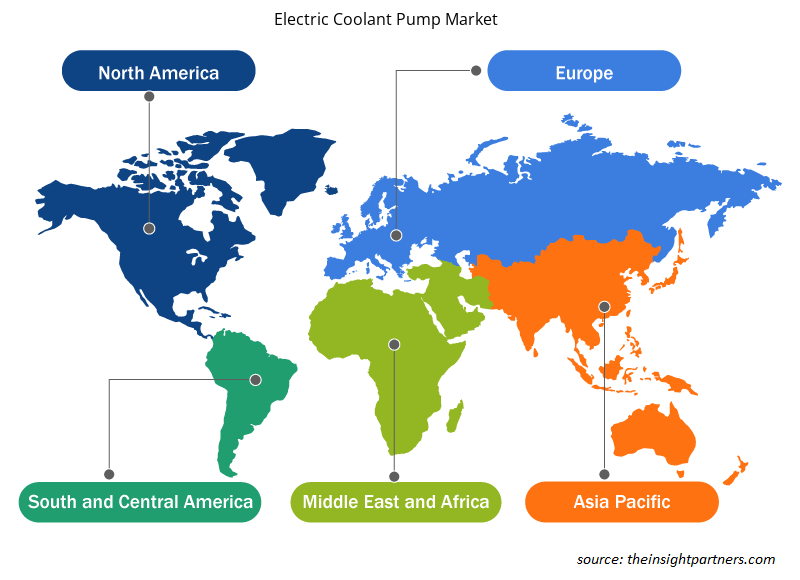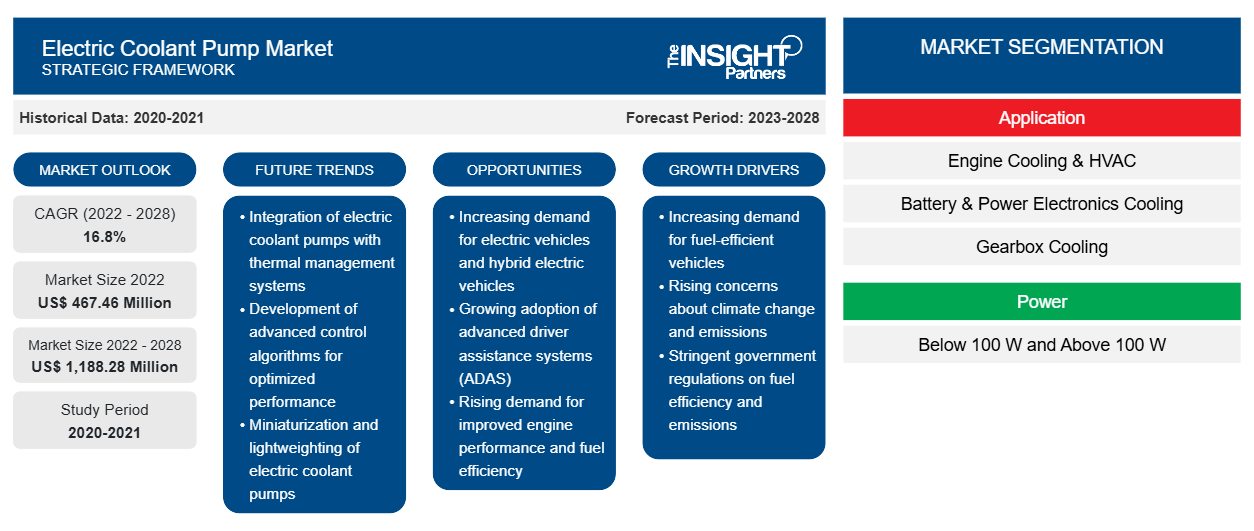2022 年电动冷却液泵市场价值为 4.6746 亿美元,预计 2022 年至 2028 年的复合年增长率为 16.8%。
电动冷却液泵是汽车冷却系统中不可或缺的部件之一。它用于维持发动机温度、动力传动系统冷却和其他附件,例如电池和电力电子设备冷却。与机械驱动泵相比,电动冷却液泵具有多种技术优势。它们具有排放效率高、价格低廉、结构紧凑等特点。因此,由于减少排放的技术优势,人们对电动冷却液泵的偏好日益增加,从而推动了电动冷却液泵市场的增长。此外,汽车产量的增加和对环保汽车的需求增加也推动了对电动冷却液泵的需求。
汽车行业的技术进步不断用电子元件取代机械元件,因为它们效率高,能够处理比传统元件更高的复杂性。例如,传动系统的发展正在利用自动变速器车辆的普及,液压助力转向正在被电动助力转向取代。此外,在发动机管理系统的帮助下,传统内燃机与电子元件集成和控制。除了这些发展之外,人们日益意识到减少汽车排放,这也迫使汽车制造商在动力总成部件方面实施新的进步。因此,这些因素正在获得动力,推动全球电动冷却液泵市场的发展。
电动冷却液泵市场高度分散,供应商采用增长战略(包括产品组合、创新和战略合作伙伴关系)来参与市场竞争。为了发展业务并从 COVID-19 疫情的影响中恢复过来,市场供应商专注于快速增长的细分市场,并在增长缓慢的细分市场中保持自己的地位。
定制此报告以满足您的需求
您可以免费定制任何报告,包括本报告的部分内容、国家级分析、Excel 数据包,以及为初创企业和大学提供优惠和折扣
- 获取此报告的关键市场趋势。这个免费样品将包括数据分析,从市场趋势到估计和预测。
COVID-19 疫情对电动冷却液泵市场增长的影响
2020 年,全球经济处于顶峰时期,COVID-19 疫情爆发之初对其产生了巨大影响。这场危机阻碍了 IT 和其他行业的商业活动。中小型公司是先进技术提供商的骨干,自 2020 年疫情爆发以来,这些公司的收入急剧下降。它影响了价值链分析,并对某些公司造成了财务影响。在 COVID-19 疫情爆发之前,由于可支配收入的增加和汽车销量的上升,电动冷却液泵市场正在经历大幅增长。此外,在电动汽车开发方面也有重大投资举措,这有助于增强对电动冷却液泵的需求。然而,COVID-19 疫情的爆发减缓了投资和生产单位的速度,阻碍了电动冷却液泵市场的业务动态。由于供应链中断、生产单位关闭以及最终用户需求下降,COVID-19 疫情对电动冷却液泵市场产生了负面影响。在疫情爆发初期,所有商业交易、合作和伙伴关系都受到严重限制。疫情的爆发阻碍了 2020 年 2 月的汽车销售;此外,到 4 月份,美国汽车销量下降了 47%,欧洲汽车销量下降了 80%。根据 Statista 的报告,2020 年全球汽车销量下降至 6380 万辆,2021 年缓慢复苏,销量达到 6600 万辆。
市场洞察 – 电动冷却液泵市场
电动冷却液泵相对于机械泵的优势
电动冷却液泵消耗少量能量来执行冷却功能。它从汽车电池获取 12V 输出,并向车辆发动机提供冷却液。此外,使用电动冷却液泵时不会造成能量损失。恒定的电力可不间断地向发动机供应冷却液。然而,机械泵从曲轴提取能量,然后将能量传输到皮带和滑轮系统,最后传输到泵。因此,曲轴的真正功率从未完全传输到冷却液泵。此外,机械冷却液泵有多个运动部件,这会导致摩擦和发动机舱内产生热量。另一方面,电动泵的运动部件较少,体积小,节省空间并减少摩擦。因此,电动冷却液泵相对于机械泵的上述优势正在促进市场增长。
基于应用的市场洞察
根据应用,电动冷却液泵市场细分为发动机冷却和 HVAC、电池和电力电子冷却以及变速箱冷却。由于电动冷却液泵在冷却发动机和 HVAC 组件方面的使用增加,发动机冷却和 HVAC 部分在 2021 年占据了电动冷却液泵市场的最大份额。此外,预计电池和电力电子冷却部分将在预测期内快速增长。运行的连续性导致电池和电力电子系统中产生的热量增加,从而增加了对用于冷却应用的电动冷却液泵的需求。
基于权力的市场洞察
根据功率,电动冷却液泵市场分为 100 W 以下和 100 W 以上。由于辅助冷却用途的需求增加,100 W 以下部分在 2021 年占据了电动冷却液泵市场的较大份额。此外,由于电动汽车部署的增加,预计 100 W 以上部分在预测期内将以更快的速度增长,从而推动该部分的增长。
基于车辆类型的市场洞察
就车辆类型而言,全球电动冷却液泵市场细分为乘用车、轻型商用车和重型商用车。由于多种电动车型的供应增加,乘用车细分市场在 2021 年占据了电动冷却液泵市场的最大份额。此外,由于重型商用车销量上升,预计重型商用车细分市场在预测期内将以最快的速度增长。
基于推进类型的市场洞察
根据推进类型,电动冷却液泵市场细分为 ICE、电动和混合动力部分。2021 年,ICE 部分占据了电动冷却液泵市场的最大份额。该部分的增长主要归因于 ICE 车辆越来越多地采用电动冷却液泵,这要归功于 ICE 驱动车辆的电气化程度不断提高以及插电式电动汽车销量不断上升。此外,由于采用电动汽车的转变日益明显,预计电动部分将在预测期内以最快的速度增长。
基于泵类型的市场洞察
根据泵类型,电动冷却液泵市场分为带 ECU 和不带 ECU。2021 年,不带 ECU 的细分市场在电动冷却液泵市场中占有较大的份额。不带 ECU 细分市场的增长主要归因于预算受限的中低价位车辆销量的增加。相比之下,ECU 的成本较高,这对大多数买家来说是一个预算限制。然而,由于对带 ECU 的车辆的需求不断增加,预计带 ECU 的细分市场在预测期内将以更快的速度增长。
电动冷却液泵市场区域洞察
Insight Partners 的分析师已详细解释了预测期内影响电动冷却液泵市场的区域趋势和因素。本节还讨论了北美、欧洲、亚太地区、中东和非洲以及南美和中美洲的电动冷却液泵市场细分和地理位置。

- 获取电动冷却液泵市场的区域特定数据
电动冷却液泵市场报告范围
| 报告属性 | 细节 |
|---|---|
| 2022 年市场规模 | 4.6746亿美元 |
| 2028 年市场规模 | 11.8828亿美元 |
| 全球复合年增长率(2022 - 2028) | 16.8% |
| 史料 | 2020-2021 |
| 预测期 | 2023-2028 |
| 涵盖的领域 | 按应用
|
| 覆盖地区和国家 | 北美
|
| 市场领导者和主要公司简介 |
|
电动冷却液泵市场参与者密度:了解其对业务动态的影响
电动冷却液泵市场正在快速增长,这得益于终端用户需求的不断增长,而这些需求又源于消费者偏好的不断变化、技术进步以及对产品优势的认识不断提高等因素。随着需求的增加,企业正在扩大其产品范围,进行创新以满足消费者的需求,并利用新兴趋势,从而进一步推动市场增长。
市场参与者密度是指在特定市场或行业内运营的企业或公司的分布情况。它表明在给定市场空间中,相对于其规模或总市场价值,有多少竞争对手(市场参与者)存在。
在电动冷却液泵市场运营的主要公司有:
- 爱信精机株式会社
- 大陆汽车集团
- 翰农系统
- 日立汽车系统有限公司
- 德昌电机控股有限公司
免责声明:上面列出的公司没有按照任何特定顺序排列。

- 了解电动冷却液泵市场顶级关键参与者概况
电动冷却液泵市场的参与者主要致力于开发先进、高效的产品。
- 2022 年 5 月,汽车行业热能和能源管理解决方案提供商 Hanon Systems 宣布在中国湖北开设新工厂。据 Hanon Systems 总裁兼首席执行官 Min Sung 介绍,该公司将继续通过投资设计尖端环保汽车解决方案和协助电动汽车类别的制造商来拓展其全球业务。
- 2021 年 1 月,MAHLE 售后市场计划将销售额提高 18.5%(约 11 亿欧元)。MAHLE 售后市场业务得到扩展,包括一系列解决方案,允许独立维修厂对电动汽车电池进行诊断和维护。为了确保在全球供应链紧张的情况下仍能交货,该业务部门重新调整了物流结构,并坚定不移地朝着数字化方向发展。例如,未来引入全自动物流中心将确保快速、无差错的交货。
公司简介:
- 爱信精机株式会社
- 大陆农业
- 捷运公司
- 翰农系统
- 日立汽车系统有限公司
- 德昌电机控股有限公司
- 马勒有限公司
- 莱茵金属汽车股份公司
- 罗伯特·博世有限公司
- 深圳市沃维科技有限公司
- 历史分析(2 年)、基准年、预测(7 年)及复合年增长率
- PEST 和 SWOT 分析
- 市场规模价值/数量 - 全球、区域、国家
- 行业和竞争格局
- Excel 数据集


- Fill Finish Manufacturing Market
- Analog-to-Digital Converter Market
- Small Internal Combustion Engine Market
- Transdermal Drug Delivery System Market
- Micro-Surgical Robot Market
- Trade Promotion Management Software Market
- Europe Industrial Chillers Market
- Photo Printing Market
- Terahertz Technology Market
- Mobile Phone Insurance Market

Report Coverage
Revenue forecast, Company Analysis, Industry landscape, Growth factors, and Trends

Segment Covered
This text is related
to segments covered.

Regional Scope
North America, Europe, Asia Pacific, Middle East & Africa, South & Central America

Country Scope
This text is related
to country scope.
常见问题
The driving factors impacting the Electric coolant pump market are
1. Advantages of Electric Coolant Pumps Over Mechanical Pumps
2. Increase in Production of Vehicles and Rise in Demand for Eco-Friendly Vehicles
The Future trends impacting the electric coolant pump market are increase in number for electric vehicles
The global electric coolant pump market was valued at US$ 467.46 million in 2022.
US, Germany, India, South Africa, and Brazil are the countries are registering a high growth rate during the forecast period.
The key players holding the major market share of electric coolant pump are AISIN SEIKI Co., Ltd., Continental AG, Hanon Systems, Mahle GmbH, Robert Bosch GmbH, Inc.
APAC is the fastest-growing regional market in the global Electric coolant pump market in 2021.
The incremental growth of the electric coolant pump market during the forecast period is US$ 720.82 million with a CAGR of 16.8%
The engine cooling and HVAC segment led the electric coolant pump in 2021.
The global electric coolant pump market size is projected to reach US$ 1,188.28 million by 2028.
Trends and growth analysis reports related to Automotive and Transportation : READ MORE..
The List of Companies - Electric Coolant Pump Market
- AISIN SEIKI Co.Ltd.
- Continental AG
- Hanon Systems
- Hitachi Automotive Systems, LTD
- Johnson Electric Holdings Limited
- Mahle GmbH
- Rheinmetall Automotive AG
- Robert Bosch GmbH
- GMB CORPORATION
- VOVYO Technology Co., Ltd
The Insight Partners performs research in 4 major stages: Data Collection & Secondary Research, Primary Research, Data Analysis and Data Triangulation & Final Review.
- Data Collection and Secondary Research:
As a market research and consulting firm operating from a decade, we have published and advised several client across the globe. First step for any study will start with an assessment of currently available data and insights from existing reports. Further, historical and current market information is collected from Investor Presentations, Annual Reports, SEC Filings, etc., and other information related to company’s performance and market positioning are gathered from Paid Databases (Factiva, Hoovers, and Reuters) and various other publications available in public domain.
Several associations trade associates, technical forums, institutes, societies and organization are accessed to gain technical as well as market related insights through their publications such as research papers, blogs and press releases related to the studies are referred to get cues about the market. Further, white papers, journals, magazines, and other news articles published in last 3 years are scrutinized and analyzed to understand the current market trends.
- Primary Research:
The primarily interview analysis comprise of data obtained from industry participants interview and answers to survey questions gathered by in-house primary team.
For primary research, interviews are conducted with industry experts/CEOs/Marketing Managers/VPs/Subject Matter Experts from both demand and supply side to get a 360-degree view of the market. The primary team conducts several interviews based on the complexity of the markets to understand the various market trends and dynamics which makes research more credible and precise.
A typical research interview fulfils the following functions:
- Provides first-hand information on the market size, market trends, growth trends, competitive landscape, and outlook
- Validates and strengthens in-house secondary research findings
- Develops the analysis team’s expertise and market understanding
Primary research involves email interactions and telephone interviews for each market, category, segment, and sub-segment across geographies. The participants who typically take part in such a process include, but are not limited to:
- Industry participants: VPs, business development managers, market intelligence managers and national sales managers
- Outside experts: Valuation experts, research analysts and key opinion leaders specializing in the electronics and semiconductor industry.
Below is the breakup of our primary respondents by company, designation, and region:

Once we receive the confirmation from primary research sources or primary respondents, we finalize the base year market estimation and forecast the data as per the macroeconomic and microeconomic factors assessed during data collection.
- Data Analysis:
Once data is validated through both secondary as well as primary respondents, we finalize the market estimations by hypothesis formulation and factor analysis at regional and country level.
- Macro-Economic Factor Analysis:
We analyse macroeconomic indicators such the gross domestic product (GDP), increase in the demand for goods and services across industries, technological advancement, regional economic growth, governmental policies, the influence of COVID-19, PEST analysis, and other aspects. This analysis aids in setting benchmarks for various nations/regions and approximating market splits. Additionally, the general trend of the aforementioned components aid in determining the market's development possibilities.
- Country Level Data:
Various factors that are especially aligned to the country are taken into account to determine the market size for a certain area and country, including the presence of vendors, such as headquarters and offices, the country's GDP, demand patterns, and industry growth. To comprehend the market dynamics for the nation, a number of growth variables, inhibitors, application areas, and current market trends are researched. The aforementioned elements aid in determining the country's overall market's growth potential.
- Company Profile:
The “Table of Contents” is formulated by listing and analyzing more than 25 - 30 companies operating in the market ecosystem across geographies. However, we profile only 10 companies as a standard practice in our syndicate reports. These 10 companies comprise leading, emerging, and regional players. Nonetheless, our analysis is not restricted to the 10 listed companies, we also analyze other companies present in the market to develop a holistic view and understand the prevailing trends. The “Company Profiles” section in the report covers key facts, business description, products & services, financial information, SWOT analysis, and key developments. The financial information presented is extracted from the annual reports and official documents of the publicly listed companies. Upon collecting the information for the sections of respective companies, we verify them via various primary sources and then compile the data in respective company profiles. The company level information helps us in deriving the base number as well as in forecasting the market size.
- Developing Base Number:
Aggregation of sales statistics (2020-2022) and macro-economic factor, and other secondary and primary research insights are utilized to arrive at base number and related market shares for 2022. The data gaps are identified in this step and relevant market data is analyzed, collected from paid primary interviews or databases. On finalizing the base year market size, forecasts are developed on the basis of macro-economic, industry and market growth factors and company level analysis.
- Data Triangulation and Final Review:
The market findings and base year market size calculations are validated from supply as well as demand side. Demand side validations are based on macro-economic factor analysis and benchmarks for respective regions and countries. In case of supply side validations, revenues of major companies are estimated (in case not available) based on industry benchmark, approximate number of employees, product portfolio, and primary interviews revenues are gathered. Further revenue from target product/service segment is assessed to avoid overshooting of market statistics. In case of heavy deviations between supply and demand side values, all thes steps are repeated to achieve synchronization.
We follow an iterative model, wherein we share our research findings with Subject Matter Experts (SME’s) and Key Opinion Leaders (KOLs) until consensus view of the market is not formulated – this model negates any drastic deviation in the opinions of experts. Only validated and universally acceptable research findings are quoted in our reports.
We have important check points that we use to validate our research findings – which we call – data triangulation, where we validate the information, we generate from secondary sources with primary interviews and then we re-validate with our internal data bases and Subject matter experts. This comprehensive model enables us to deliver high quality, reliable data in shortest possible time.


 获取此报告的免费样本
获取此报告的免费样本